Eyewitness: Human Toll of Eight-Year Ukrainian Army Onslaught in Eastern Ukraine is Shocking

The eastern Ukrainian countryside is being littered with Ukrainian Army mines while some towns have been abandoned as residents had to escape Ukrainian Army shelling.
Residents consider Americans who send money to the Ukrainian government in the belief that they are protecting them from the Russians to be “idiotic” and “foolish.”
The third part of an eyewitness report. (See Part 1; and Part II)
From May 1 to May 12, I traveled to both Russia and the Lugansk People’s Republic, an independent republic in the Donbas region, formerly part of eastern Ukraine. The purpose of this fact-finding mission initiated by the Socialist Unity Party and Struggle-La-Lucha.org was to report the suppressed information challenging the narrative of NATO and its member states, led by the U.S., in this proxy war in Ukraine against Russia.
My visit to Lugansk was made possible with the assistance of Borotba (Struggle), a socialist political organization in Ukraine and Donbas that we have worked with for many years. Alexey Albu, one of the leaders of Borotba, also provided translation for me during interviews. This is the third part of my report.
On May 8, two days after we visited the Rubizhne shelter, we made our way from Lugansk city to the villages of Sokilnyky and Krymske. Both had recently been taken over by the joint forces of the Lugansk People’s Militia (LPM) and the Russian military.
After the 2014 U.S.-sponsored coup in Ukraine that brought to power a pro-Washington, anti-Moscow regime partnering with fascist forces, the majority Russian-speaking people of the Donbas region decided they did not want any part of this backsliding of history.
Dramatic evidence of the new coup government’s fascist leanings came in its support for the neo-Nazis who burned alive activists at Odessa’s House of Trade Unions on May 2, 2014. To this day, none of the perpetrators has been charged with any crime. Given that incident, the people of the Donbas region declared themselves the independent Donetsk and Lugansk People’s Republics (DPR and LPR). They voted by 89% in Donetsk and 96% in Lugansk for that change.
Instead of honoring the wishes of the people of Donbas, Kyiv labeled them terrorists and sent armed forces with heavy artillery and aircraft against civilians, threatening to wipe out the population. The Lugansk People’s Militia was organized to defend the area.
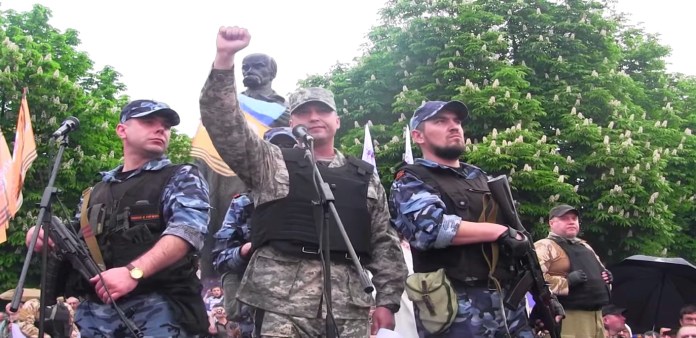
Valery Bolotov proclaims the Act of Independence of the Lugansk People’s Republic, May 12, 2014. [Source: wikipedia.org]
When the Minsk II cease-fire agreements took effect in 2015, the opposing sides’ positions were drawn. Sokilnyky was controlled by the Lugansk People’s Republic. Krymske was occupied and controlled by the Ukrainian military.
If the cease-fire stipulations under the Minsk II agreements were adhered to by the Ukrainian military, it would have protected this community. Instead, the agreement was used by Ukraine to create a one-sided shooting range against civilians in Sokilnyky. Today no one lives there and the homes and buildings have been destroyed.

Source: nationsonline.org
The road that runs between Sokilnyky and Krymske is called Vulytsya Horkoho, named for the great Russian writer Maxim Gorky. Google also translates it as “Bitter Street.” The name is fitting since less than a quarter-mile north runs the Siverskyi Donets River—the border between two conflicting sides in a war.
When you travel along this road toward Sokilnyky, you see idle and broken-down Ukrainian tanks that were used against the villagers after 2014, when no military force was there to protect those communities.
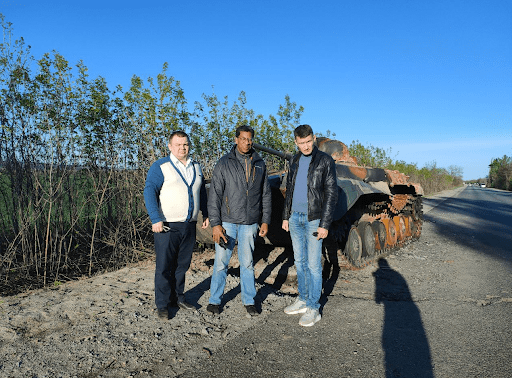
From left: Alexey Albu of Borotba; John Parker of Socialist Unity Party; and Evgeniy Miroshnichenko, member of the Youth Parliament, State Duma of Russia. [Source: Photo courtesy of John Parker]
Ukraine continued war after Minsk II
The 122-mm shells from the Ukrainian government’s arsenal rained down on villagers from the north of the river’s edge and west of Sokilnyky, aimed at anyone driving along this road or just relaxing at home. These shells are capable of stopping tanks, penetrating bunkers and taking down aircraft. And as we could see along the way, many homes were blown to bits or barely left standing.
The 2015 Minsk II agreements were negotiated by Russia, Ukraine, Germany, France and the Donetsk and Lugansk republics, allowing for some self-determination of the Donbas regions and the right to be protected by their own military forces—the Lugansk People’s Militia and the Donetsk People’s Militia.
By 2017, however, most residents on this road east of Krymske who survived left the area since it was too dangerous.
Although the Minsk agreements forbade attacks within this area, our guide told us that, after 2015, the Lugansk militia forces began calling this street the “Road of Life,” where LPR forces had to travel fast to keep from being shot at. “For seven years Nazis violated the Minsk agreements…They attacked peaceful people who lived in this village during those Minsk violations,” explained our LPM guide, who led us to our next location further west toward Krymske.
We saw further evidence of houses resembling Swiss cheese rather than safe spaces for families. We stopped on the edge of Zynamyanka village, where a monument commemorating fallen World War II soldiers was located. We had to follow the steps of the person in front since the area was filled with unexploded shells dropped by the Ukrainian forces.
We reached an administrative building that was now more cinder block pieces than structure. Two wires strewn across our path warned us not to go any further since that area was not partially cleared of unexploded shells or mines.
Against the advice of our guide, a very brave journalist from the news service Izvestia continued walking and laying a path for us. Why would he take such a risk? Because, he said, he felt it was important for us to see up close the monument with the names of those from this and nearby villages of both Ukrainian and Russian Soviet soldiers killed fighting the Nazi threat during World War II—so we could appreciate the respect these residents had for their relatives who fought fascists. And to appreciate their suffering in being targeted by those who adhere to that same fascist ideology.
My comrades insisted they walk in front of me, following the soldier from the LPM. Then it hit me hard. From our friends in Borotba to the guides from the Lugansk People’s Militia and brave journalists dedicated to telling the truth—they were all here assisting me, putting their bodies on the line to keep me safe, because they believed the message I would relay back to the U.S. was that important.
I truly wish the U.S. anti-war movement that has so cynically and arrogantly dismissed any facts or testimony coming from the people in Lugansk and Donetsk, who refuse to acknowledge their experiences or even existence, could feel just one-tenth of what I felt in that moment.
When we reached the monument, carefully, the words with the hundreds of names of buried soldiers read: “Your Heroism Is Immortal and Your Glory Is Eternal.”
Sister towns separated by war
The once Ukrainian-held territory in and around Krymske, just west of us, included areas within eyeshot of the LPR-held Sokilnyky village. In 2014 almost 2,000 people lived in Krymske, and 1,000 lived in Sokilnyky. They lie about five minutes from each other by car.
In fact, the communities were very close. One of the Izvestia reporters with us wrote: “If a guy from Krymske married a girl from Sokilnyky, the wedding was played in two villages at once.” But after the battles in 2014 and by 2015, the two communities remained separated with blocks of concrete and barbed wire.
After passing the town of Sokilnyky, we drove about a quarter mile to where the Ukrainian military had installed bunkers and barracks to target that village, using these places to launch missiles and those 122-mm shells against the LPR-held territories, even in the years when civilians were still there.
The south side of this “Bitter Street” had been swept for mines but the north side had not, so to remain relatively safe we stayed on the south side. On the ground were strewn Kalashnikov 5.45 caliber bullets and casings leading into an eight-foot dugout to tunnels of dirt and darkness protected by sandbags from retaliatory fire.
The Ukrainian forces were routed after the February operation by the Russians and the LPM so, undoubtedly, gunfire was exchanged. But even if there was activity targeting this compound in response to shelling, it lies more than a quarter-mile from 99% of the homes in the Krymske village.
In other words, the civilian population living in Krymske village was only victimized by the Azov, Aidar or Right Sector fascist regiments leading the Ukrainian military occupation there. This is according to the residents we spoke to, who also verified that those leading these soldiers were wearing Nazi regiment colors and fascist symbols.
About 100 feet down the road from the bunker, taking us to the eastern edge of Krymske, we observed on the side of the road a leftover decoy that had been used to frighten the Lugansk militia forces, mimicking a Swedish surface-to-air missile. The threat would have been believable since those real missiles and other military aid totaling $102 million was promised to Ukraine from Sweden on June 2—this on top of the other anti-armor weaponry already delivered.
Sweden’s AT4 anti-armor weapon
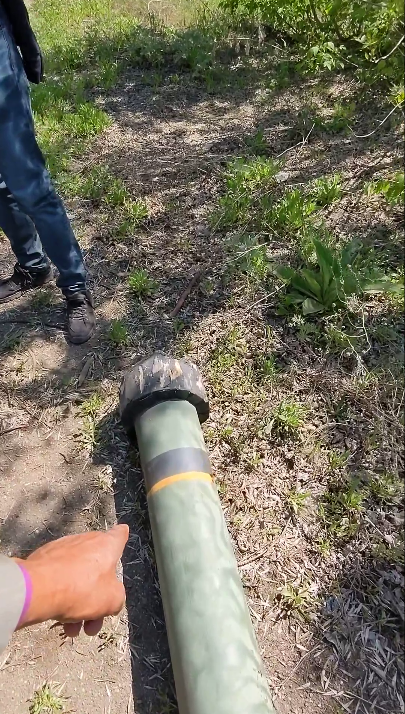
My photo of a decoy surface-to-air missile weapon by a bunker near Sokilnyky. [Source: Photo courtesy of John Parker]
Nazi symbols
Due to the actual weapons present at that moment, the most common phrase I heard observing these sites was again, “Don’t step there”—not only because of the unexploded shells on this side of the river but also because the Ukrainian military would “sow” the area with mines that could not be seen in the grass.
We then drove a few feet further to a complex that was part of a tuberculosis clinic. The Ukrainian forces retrofitted this clinic for war by evicting the patients and health-care staff. In one of the buildings, the Ukrainian soldiers felt comfortable enough to scrawl in large letters the word representing a fascist soccer team in Ukraine, the ULTRAS—a team, we were told by one of the journalists with us, that is owned by an oligarch who funds Nazi regiments.
Something that seemed out of place, given the graffiti praising Nazi symbols and organizations, was a letter shaped as a heart with the colors of the Ukrainian flag from a child thanking these Nazi-led Ukrainian forces for keeping them safe. That is not surprising, since the Azov Battalion set up children’s “educational” facilities. According to a Time article from January 7, 2021, the battalion even has an entire building lent to them by the Zelensky government in Kyiv that serves such a purpose.
In addition to general misinformation passed on in their libraries, this facility raises funds by selling key chains, t-shirts and other items adorned with swastikas and other Nazi symbols. Again, this building is on loan from the Ukrainian government, supporting what goes on there.
In another building here, 122-mm shells were stacked on top of each other. Their presence in this room seemed to be a testament to the threat against humanity symbolically displayed over half of one of the walls with drawings of a swastika and a Black Sun or Sonnenrad.
It should be noted that this Azov identifier is the same symbol used by the white supremacist shooter who recently targeted Black shoppers in Buffalo, New York. He was inspired by a white supremacist in New Zealand who murdered 51 Muslim worshippers in two mosques there. That New Zealand killer said he was in contact with the Azov Battalion and planned to go to Ukraine for military training.
As shocking as this is, it should not be too surprising that young people are falling into the hands of these unchecked fascist movements. In the 2021 report “Like, Share, Recruit: How a White-Supremacist Militia Uses Facebook to Radicalize and Train New Members,” Time explained how Azov’s use of Facebook’s algorithm drives white supremacists and disaffected youth toward them, allowing Azov exponential visibility growth.
Just a few steps away, another building turned military bunker contained lookout holes punched through the walls, with coordinates written in pen giving targeting coordinates for the LPM positions and civilians when they lived there. On another wall the words “No One But Us” were written in Ukrainian in blue and yellow.
Military-industrial profits
We were accompanied by more than one camera crew with journalists representing various media from Ukraine and Russia. During our inspection of this site, one of the journalists from a Russian news agency found a container that once held explosive materials. This object, the journalist said, came from either the U.S. or a Western European country.
Of course, this is not surprising given that U.S. military aid to Ukraine, as reported in the May 20 New York Times, amounts to more money than given in any kind of aid to any country in the last decade. “It is roughly two times the amount given in 2011 to Afghanistan, the largest U.S. foreign aid recipient until now,” reported the Times.
The U.S. had already surpassed the entire defense budget of Russia back in May. Perhaps the reason for this unprecedented funding, in addition to world domination, also has to do with profits. Business Insider reported on May 23: “One of the largest defense contractors in the nation donated to nearly 150 members of Congress as they debated Ukraine military aid.”
On May 3, President Joe Biden went to Lockheed Martin’s Pike County Operations facility in Troy, Alabama, and did a photo op at the Javelin missile production facility.
And the top member of Congress in charge of the military budget, Democratic Representative Adam Smith from Washington State is also the top recipient of money from the weapons makers.
In its 2010 Citizens United decision, the United States Supreme Court ruled that corporations may spend unlimited amounts on elections. When the selfish ambitions of bought-and-paid-for politicians coincide with the goals of the ruling class, even the sky is not the limit. The death and fear created are of no consequence to them.
Speaking of fear, while exploring this hospital complex I heard a constant buzzing, like a flying bee with a megaphone. When I asked what that sound was, I was told it was from a drone overhead. This caused me some concern, knowing that in April the U.S. had been training Ukrainian soldiers in the use of a very advanced drone called the Switchblade Drone 600.
By that month, two of the lethal aid packages for Ukraine of more than $1 billion included those drones, capable of flying 24 miles. That distance was well within the area between us and the current Ukrainian positions. In fact, I could see with my own eyes the plume of smoke from recent targets hit by either the Ukrainian or Russian and Lugansk forces. And these drones carry warheads that can take out tanks.
With the recent memory of Ukrainian forces bombing an apartment building near the shelter where we were conducting interviews in Rubizhne, I felt a bit uneasy about that noise overhead and was therefore happy when we later returned to the cars to continue on our way.
As we continued to Krymske, the site of almost all of the homes intact was a startling contrast to Sokilnyky. Although a relatively small percentage of those homes were damaged, according to our LPM guide, it was due to fighting that occurred in 2014, when they were also being shelled by the Ukrainian military.
Even if those homes destroyed in 2014 were mistakenly said to come from the more recent hostilities, the comparison of the two villages makes clear that neither the LPM forces during the Minsk Agreements to the present time, nor the Russian military that came in February, carried out any bombing campaign against Krymske.
“Everything Zelensky says is a lie”
When we arrived in Krymske there were a few children running around and playing—finally.
A stark difference from the situation at the Rubizhne shelter, where kids could not play for any significant length of time due to their proximity to the front lines and therefore within reach of the Ukrainian delivery of shells.
The only deliveries now being made are those of food and other humanitarian aid coming from the city of Lugansk. It is received at the former village council building.
With the exception of one person, all the residents I interviewed were very glad about the presence of Russian soldiers and the Lugansk People’s Militia and the absence of the Ukrainian military.
Local resident Irina said: “In 2014, the Nazi Aidar and Right Sector battalions came to us. They entered houses and fired over our heads.”
One person did complain about the military presence. He was upset with the sentencing of his son by the Lugansk People’s Militia. His son was accused of collaborating with the Ukrainian troops. In spite of that, he still desired the protection of the military forces here now.
I was able to catch up to one of those children running around the overgrown playground, whose grass had not been cut during the Ukrainian occupation.
Eleven-year-old Ivan told me that his family left in 2014 when the Ukrainian military began attacking civilians here. His mother told him: “The windows in our house shattered, but I stayed asleep and my mom had to wake me up. Then we left.” As he spoke I saw him looking at a dog nearby. When I told him about my dogs and asked him if he had any pets, he sadly said his dog had to be left behind.
On this day, however, he seemed happy. He said that he was glad to be back since this is where his grandparents live as well. I asked him what he studies in school and he said math and science, but now school is only open two days per week.
After talking about his favorite exercise and sports—basketball and football (soccer)—I moved on to more serious topics. I told him how the newspapers and TV news in the U.S. describe the Russians as hurting the people of Ukraine and that the Ukrainian government and its military are protecting people. “What do you think?” I asked.
He told me he strongly disagreed. “It is completely untrue that Russia attacks peaceful people. Russia protects civilians and their interests. Everything Zelensky says is a lie because when he says that this is a Russian occupation it is completely untrue, it is completely a lie, Russia protects civilians.”
I figured that was enough war talk for a child and that I’d give him a break and go back to my previous challenge to race him to the edge of the building. But instead of wanting to lighten the conversation or go play like most children his age in the U.S., he wanted to give some advice to the Ukrainian military and Zelensky: “Now the Ukrainian forces hide in Donetsk, but it will be better if they give up, because the peace will come sooner and we can repair our cities.”
After thanking him for helping me get the message to people in the U.S., he said, “Yes, I told you because I understand that my words can have a little influence on people in the world and maybe peace will come more quickly here.”
Although they may run around in a playground when war is present, children are forced to ponder things they should not have to. But when war comes knocking at their door—or shattering their windows—they have no choice.
Laughter and solidarity
I then approached a few elderly women sitting on a bench. I asked about the situation here under Ukrainian military occupation. They all described the military as being led by the Aidar Battalion, which they could tell by the colors of their patches and Nazi symbols they wore.
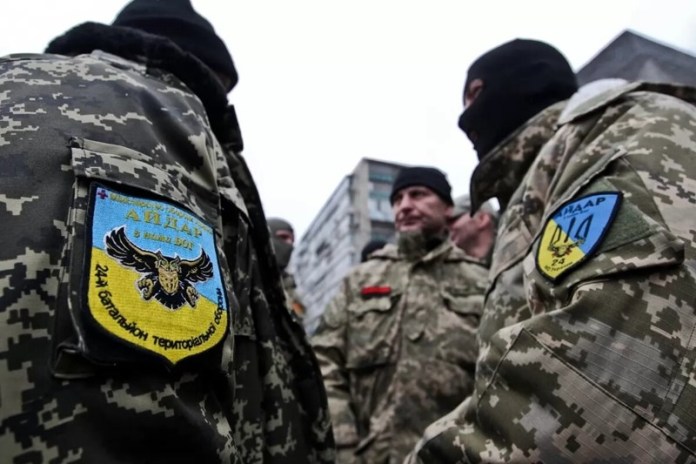
Members of Pro-Nazi Aidar Battalion who are hated by the people of eastern Ukraine. [Source: english.almayadeen.net]
They said that, although not all of the soldiers were Nazis, their leadership was. “They would make them get down on their knees and hit and humiliate them,” said one of the women about the treatment of rank-and-file soldiers who were not Nazis by their superior officers. They all assumed that this was designed to indoctrinate them.
When I asked one woman what it was like during the occupation, her eyes quickly darted down and her head gestured “no.” This made me wonder how horrible an experience she may have had, given the documented war crimes of the Aidar Battalion during this conflict, especially against women. So out of compassion for her, I did not ask again. If they humiliated their own troops, what might they have done to these civilians?
When I asked the women what they thought about people in the U.S. who send money to the Ukrainian government in the belief that they are protecting them from the Russians, one exclaimed: “Duratskiy!” A few of the definitions for that Russian word are “foolish,” “fatuous” and “idiotic.”
When Alexey told me it meant “stupid” and I repeated it in Russian, they all started laughing—first shyly, then out loud when they saw I joined them. I was glad our shared laughter communicated better than words my solidarity with their struggles here today.
The last interview in Krymske was with a member of the Communist Party. He explained the situation in 2014, when the people here demanded their governor reject the coup government in Kyiv. But, he said, the governor sided with the coup and left.
After we talked, he walked me to an area where two monuments commemorated all of the people from the village who were killed fighting the Nazis during World War II and another honoring the soldiers who were not from that village, but died there fighting the German fascist military. This individual said he was very thankful that the Ukrainian occupiers did not destroy these two monuments as they had done in other parts of the Lugansk region.
The visit to Krymske was inspiring. From the determination and wit of the women on the bench, to the 11-year-old willing to take time out from the playground for important matters, to the passion of the communist who was so proud of the monuments with names of his own family members inscribed on one of them—and all of this community’s unceasing commitment to fight fascism if it rises here once again.
It is also clear that, here, the military that is despised is the Ukrainian one. When we first arrived, we noticed people walking around as if life were normal—although it is not. But now, for the remaining residents in Krymske—no longer threatened by the Ukrainian soldiers—cessation of the worst horrors of war and occupation allows them to take a breath.
Fire in the sky
The day before we visited Krymske, Alexey Albu and Evgeniy Miroshnichenko, a member of the Youth Parliament under the State Duma of Russia, invited me on a tour of Lugansk, the capital city of the LPR. We observed the monuments and met with officials from the Lugansk city administration. We were, however, momentarily interrupted by the sight of smoke in the sky, coming from either a drone or rocket that had been intercepted by a Russian missile.
As we walked further I saw a playground and happier thoughts took over.
Playgrounds are wonderful. They are a place where children go to socialize and spend their energy with such excitement and joy. However, given the proximity of shelling or the very recent liberation of areas once occupied by the Ukrainian military, the priorities of food and shelter forced a lack of maintenance in those areas.
However, there in the city of Lugansk, which had been mostly free of attack for some time, I saw a beautiful playground full of children on the swings and slides and varied apparatus designed for the sole purpose of making joyful noises.
But what I had just seen threatening the skies above this well-attended and most precious sanctuary was a killer of children—thankfully destroyed, this time. What would have happened to this playground had the Ukrainian military, now armed with even more sophisticated weaponry thanks to the Biden administration and every other complicit politician, been successful?
The new reality we face as activists and members of organizations promoting social justice and peace is that the propaganda of the ruling class has become so capable, so well-funded, so fluid in its use of social media and Hollywood, that most, including many in the movement for social justice, are not even aware of its effects in molding our own opinions and distorting our sense of reality.
This three-part series began solely as an attempt to expose the fact that the war in Ukraine has been manufactured to further the expansion of U.S.-led NATO, targeting Russia and China. But perhaps the more important story is how the State Department and its right hand—the corporate media—are today able to so effectively use false information manufactured in such a consistent and frequent manner and build on those past prejudices against Russian people.
The political left in the U.S. and Europe has a big problem that comes from a cultural disease developed especially by U.S. capitalism’s history of racism. Not only is there class bias, but the added dehumanization with all its arrogant trappings intrinsic to the system of racism carries over to anyone deemed as “the other.”
In the U.S., the “other” is usually anyone who is non-white and is therefore not taken as seriously, not as believable, not as legitimate and reliable a source of information, and definitely not due as much empathy. This is even carried over to certain white people deemed as the other. And we are told by the U.S. government who the latest other is—sometimes it is the Iraqis and their leaders, or it is the Syrians and their leadership, or the Libyans and their leadership.
Despite the fact that information that comes from the U.S. corporate media during a U.S. war drive is consistently false—from the Lusitania incident in 1915 or the Gulf of Tonkin lie pushing the U.S. into war with Vietnam or the lies pushing war in Iraq and Libya—we are supposed to accept it as gospel and reject all information coming from the official or unofficial sources from the latest target of U.S. imperialism.
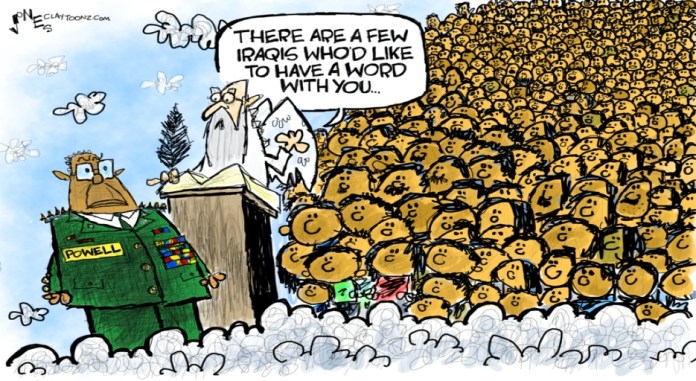
Source: claytoonz.com
This is why the sources of information that comes directly from white supremacist neo-Nazi military organizations in Ukraine is more trusted than those in the Donbas region—because the people of Donbas, in Lugansk and Donetsk, are now among the other.
My friends from Borotba, the Communist Party of the Russian Federation, the United Communist Party—the other; the 82-year-old woman from the shelter in Rubizhne, who was crying over the bombing of her home by Ukrainian tanks and the loss of all her belongings; and the women in Krymskoye who identified the Right Sector and Aidar Batallion as their occupiers and torturers; the entire political and religious leadership in Lugansk; the Lugansk People’s Militia members—all the other.
And even to much of the “left” in the U.S. and Western Europe, who refused to even acknowledge their existence, they are deserving of neither an ear nor a heart for empathy.
Is the history of the Soviet Union or Russia, before this current conflict, filled with the intentional targeting of civilians in any degree close to that of the U.S. military and NATO?
Did the Soviet Union yesterday, or Russia today, participate in European and U.S. colonialism or neocolonialism, or have a worldwide troop deployment and military bases anywhere near that of the U.S. or NATO?
Some will say that Russia is not the Soviet Union and it is now capitalist. Well, so are Finland and Sweden. But because years of Cold War propaganda did not target the integrity of the people of Finland and Sweden, folks see them in a different light—even though those governments said nothing about the NATO expansion for the past 20 years that caused this crisis and are now enabling and actively expanding the most belligerent military alliance in history at this critical and dangerous moment in time.
Accusations that are today thrown against Russia, if thrown against their people or soldiers, would not be so easily believed, even though the people of Sweden and Finland did not play the deciding role in defeating fascism in World War II that the people of Russia heroically played.
Hopefully, this information countering the lies of the ruling class will help to refocus our attention on the reality that the U.S. and its imperialist allies are driving us not toward fighting runaway inflation that threatens to impoverish us all, and not toward solutions stopping life-threatening climate change, but are instead driving us toward World War III. And that is a very bad thing.
So let’s refocus, quickly.
*
Note to readers: Please click the share buttons above or below. Follow us on Instagram and Twitter and subscribe to our Telegram Channel. Feel free to repost and share widely Global Research articles.
John Parker is a 2022 Socialist Unity Party and Peace and Freedom Party candidate for the U.S. Senate from California. Parker has been a union organizer, public school teacher, and is the Coordinator of the Harriet Tubman Center for Social Justice. John can be reached at [email protected].
Featured image: John Parker walking through a Ukrainian bunker west of Sokilnyky. [Source: Photo courtesy of John Parker]
This article has been archived for your research. The original version from Global Research can be found here.


